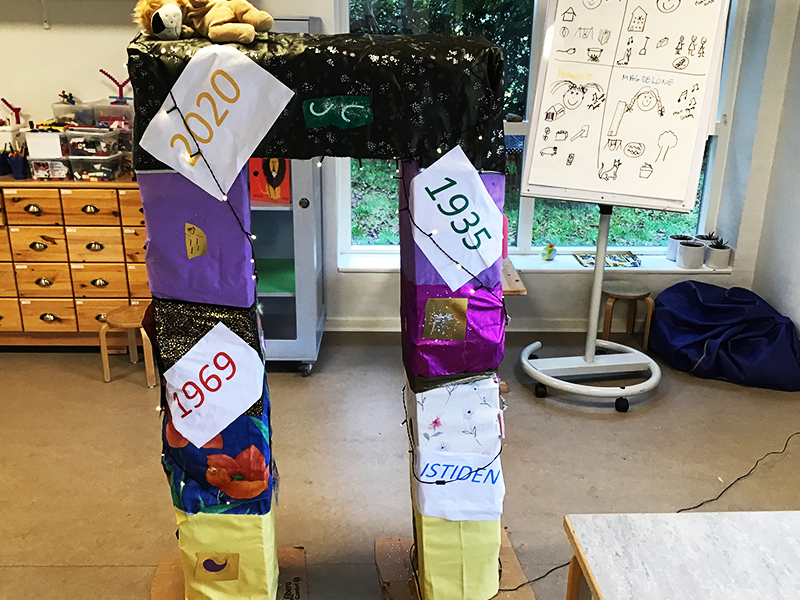DIGITAL MEDIA, STORYTELLING, PLAY
Region: South
Municipality: Vejle
By: Givskud
Year: 2020
Artist: Jacob Knudsen
Day care: Stjerneskuddet Kindergarten
Stjerneskuddet lives right across from Givskud Zoo and has used the place for many years for outings with the children.
How can this continue to be exciting and interesting for both children and educators? Can we find new ways to use Givskud Zoo? And can we use the history of the place to also work with history and understanding of time together with the children?
The aim is to explore the above through the idea of a special suitcase of old things that can be used to take children back in time - to when Givskud Zoo opened in 1969, to a small zoo set up by a local master tailor in the early 1930s, and to the Ice Age (there is an Ice Age landscape in Givskud Zoo). These elements are linked to storytelling and the "old days"
It was all built around a visit to Givskud Zoo, a story about four children who find a magical gate that helps them travel through time. They also find a magic suitcase with objects from different time periods and visit Givskud Zoo in the present, 1969 when it opened, its predecessor in the 1930s and then an ice age landscape in Givskud Zoo. Then they play and experiment with the objects, and incorporate digital media along the way: robots and apps.
The story was divided into four parts. One for each time period we visited in our project and was developed together with the children. The story was read out to start the different activities and set the scene for the particular time period being explored.
How has it gone in relation to the overall wonder?
It has been an exciting project for everyone to be involved in. Partly because, in addition to an artist, we also had a visiting scientist. This has meant that there has been a lot of experimentation, but also extra focus on pedagogical work and how we did things.
We think we have achieved what we set out to do. Not necessarily always in the way we imagined, but you can't expect that when you're experimenting and following in the footsteps of children.
We've got a lot of concrete ideas that could be combined in new ways. Ideas that, besides being new ways to visit Givskud Zoo, can help the children to an understanding of time and that the world once looked different. And we have discovered how to use robots and apps as a natural part of educational activities and storytelling.
Professionally, it has given us a good overview of what it takes to run an artistic project, following the children's tracks and experimenting. You have to be able to improvise and give space to others. You have to be able to stand strong in your professionalism and it's good to have a broad experience. You must be able to listen to the children and create common areas of interest and contact. And you have to be able to finish what the other person has started.
In addition, there have been several good experiences of what the project has meant for the children.
On the one hand, the framework has been very good. There has been good structure with room to improvise within the framework.
An important part of this structure was created by working together to build a special transformation gate that formed the starting point for the time travels. Partly by paying particular attention to creating a good group division that allowed everyone to join in.
It has been important to have something very tangible to touch. Concrete things that can help strengthen the imagination.
We have tried to create a good interaction between the known and the unknown to create both structure and space for experimentation. This meant, for example, that the project's magic suitcase was known to the children, but not its contents, which changed from time to time.
Givskud Zoo was well known to the children, but they didn't know what to do and we made an effort to find new ways to play in the park. For example, we could play agents with the objects in the suitcase and use Givskud Zoo and the other guests as a backdrop for our play.
We were always thinking in terms of differences. That is, many of the objects in the suitcase were known to the children, but they did not know the version that was in the suitcase. An example was that the children knew mobile phones, but not old-fashioned rotary phones.
And we mixed imagination with movement. That is, we often had special movements when we "hit". For example, sneaking off or whispering.
There are several children who have shined and shown skills they do not usually show. There are children who still draw threads back to the experiences.
There have been funny little stories, like the one about a boy who found a flint and could break it. He loved the Ice Age. There was the one who could tell a long story and make it hang together. Or the one about someone who wanted to sing a song about a unicorn. She did and it's spread to the others.
What's next? What are we still curious about?
We need to work on the form, see if it can be simplified and make it work in a busy day.
And we may have to play on with robots and travel forward in time. Both to reinforce work with time, but also to introduce children to technology and digital literacy.
click on the picture to see a larger version



